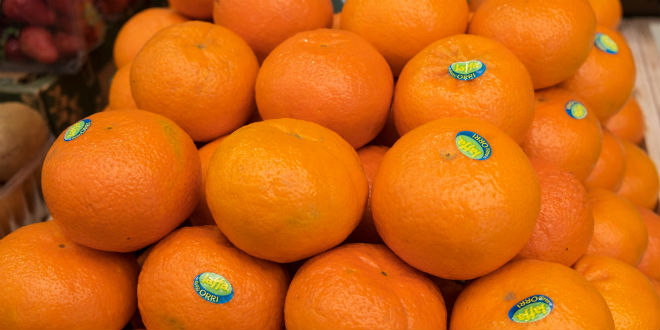The word “Jaffa” is mentioned four times in the Bible – as a city opposite the territory given to the Hebrew Tribe of Dan (in the Book of Joshua); as port-of-entry for the cedars of Lebanon for Solomon’s Temple (in 2 Chronicles and Ezra); and as the place whence the prophet Jonah embarked for Tarshish.
But the word “oranges” does not appear in the Scriptures at all.
Yet Israel is best known to many people around the world for its Jaffa oranges, which in fact didn’t even originated in the Middle East. The sweet variety of this citrus fruit came from China, brought to Portugal by explorer Vasco De Gama and then on to the Holy Land.
The original citrus plantations were run by wealthy Arab landowners, and in 1845, the land of Israel exported as many as 200,000 oranges. But five years later, British philanthropist and banker Sir Moses Montefiore purchased plots of land and planted orange groves. In 1885, Baron Edmond de Rothschild planted more orchards in developing agricultural settlements such as Petah Tikva, giving the area the sweet smell of oranges. The growers developed significant expertise in agriculture as they gradually improved the quality of their produce.
Tel Aviv, located on the coast of Israel not far from the citrus orchards, became known as the “Big Orange,” just as New York’s knickname is “The Big Apple.”
Over the decades, the cultivation of oranges developed until the fruit became one of Israel’s most famous and profitable experts. But in recent years, the shortage of land for housing caused many to trees to be chopped down and covered by apartment buildings. The number of Israeli farms declined as fewer farmers grew food for local consumption. Although Jaffa oranges are still grown from November to March, by some Israeli farmers, hi-tech has in large part taken over for the fruit. In addition, many people had become too lazy to peel oranges and preferred fruit that can be gobbled down faster
Known as the Shamouti variety of oranges, Jaffa are – along with the bitter orange and navel orange – is one of the three major types of the fruit grown in the Mediterranean. The Shamouti is sweet and has a tough skin that makes it very suitable to export and to peel. Sudden cold weather does not faze the fruit, which also boasts a minimum of seeds and a bountiful supply of vitamin C.
But there is good news about Jaffa citrus fruits. Israel’s Plant Production and Marketing Board predicts that 2019 will see significant increase in exports of the Orri Jaffa mandarin to the US and Canada. The organization set goals for expanding export of its leading, easy-to-peel mandarin in response to the increased demand for high-quality, easy-peelers.
The Jaffa Orri is a mandarin developed by scientists at the Israeli Volcani Research Center. Mandarins are reddish-orange and can be sold as tangerines. Mandarins are smaller and flattened at the ends, instead of being spherical like ordinary oranges. Their taste is sweet and strong.
The easy-to-peel Jaffa Orri mandarin offers an excellent, fresh, sweet flavor with a fleshy texture and juiciness, while bearing virtually no seeds. It also carries a particularly long shelf life and appears later in the season compared to other easy peelers – from January into May.
The American citrus market has been growing significantly in recent years and is composed largely of imports. The mandarin sub-category is the largest in the citrus category, accounting for some 40% of the citrus market. More than 230,000 tons of easy-to-peel mandarins are shipped to the US annually, at a total value of more than $1 billion. This is in addition the 1 million tons grown for the Israeli market, as fruit or for making juice.
Data from studies conducted in recent years confirm a doubling of per-capita consumption of mandarins in the past two decades. This coincides to a significant increase in the intake of easy-peelers in the US market, mainly in place of traditional oranges. In recent years, this phenomenon has led to a sharp upsurge in the import of easy-peelers to America, leading to the establishment of new groves.
“The US market for easy-to-peel mandarins is substantial and holds promise as a developing target market for Israeli citrus exports,” says Tal Amit, director of the citrus division in the Plant Production and Marketing Board. “The success of easy-peeler mandarins in particular can be easily credited to the fruit’s great flavor and unbeatable convenience.”
Over the past five seasons, citrus exports from Israel to North America have increased from 3,000 tons to 9,000 tons last season, of which about 5,300 tons are easy-to-peel mandarins. This season, export of Orri Jaffa mandarin alone is expected to reach 9,000 tons, constituting a potential 70% growth.
In spite of this significant rise in consumption of the mandarins in the US, consumption per capita is among the lowest in the world, about 2.5 kilos per capita per year. But based on the rapidly increasing demand, that figure is forecast to double. In Canada that figure is almost doubled, reaching 4.6 kilos per person.
Orri Jaffa mandarins are currently exported to 45 countries worldwide. Most of the yield is exported to Europe (78%). The most prominent outlets in Europe of the popular fruit are: France (39%), the Netherlands, Scandinavia and Russia (7% each). About 18% of the fruit is shipped to North America, and 4% to Asia Pacific.
The Plant Production and Marketing Board was established in 2004 to help farmers in advancing their agricultural missions. The board promotes the Jaffa brand and other registered citrus industry brands. It helps kick-start pioneering research and development projects, executes centralized crop protection initiatives, assists organizations in meeting sanitary standards for produce and insures growers against weather-related losses.
Source: Israel in the News

